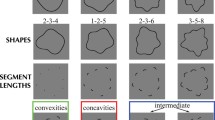Abstract
We present a qualitative shape description which has previously been proven to be useful for object categorisation. The description is based on a set of shape primitives which we will restrict to a new subset of relations representing stylised curvature information. In contrast to other qualitative shape theories, this description enables us to distinguish different convex shapes. This is especially interesting from a cognitive point of view since these shapes show salient visual differences. It turns out that the distinction between two sides of a line together with the distinction between acute and obtuse angles make up a powerful concept of orientation information for shapes in two dimensions.
Access this chapter
Tax calculation will be finalised at checkout
Purchases are for personal use only
Preview
Unable to display preview. Download preview PDF.
Similar content being viewed by others
References
Attneave, F.: Some informational aspects of visual perception. Psychological Review 61, 183–193 (1954)
Biederman, I.: Recognition-by-components: A theory of human image understanding. Psychological Review 94, 115–147 (1987)
Cohn, A.G.: A hierarchical representation of qualitative shape based on connection and convexity. In: Kuhn, W., Frank, A.U. (eds.) COSIT 1995. LNCS, vol. 988, pp. 311–326. Springer, Heidelberg (1995)
Cordella, L.P., Vento, M.: Symbol recognition in documents: a collection of techniques? International Journal on Document Analysis and Recognition 3, 73–88 (2000)
Freksa, C.: Temporal reasoning based on semi-intervals. Artificial Intelligence 94, 199–227 (1992)
Freksa, C., Zimmermann, K.: On the utilization of spatial structures for cognitively plausible and efficient reasoning. In: IEEE International Conference on Systems, Man and Cybernetics, Chicago, pp. 261–266 (1992)
Galton, A., Meathrel, R.C.: Qualitative outline theory. In: Dean, T. (ed.) Proc. of 16th IJCAI 1999, pp. 1061–1066. Morgan Kaufmann, Inc., Stockholm (1999)
Gottfried, B.: Tripartite Line Tracks. In: Wojciechowski, K. (ed.) International Conference on Computer Vision and Graphics, Zakopane, pp. 288–293 (2002)
Horng, J., Li, J.T.: An automatic and efficient dynamic programming algorithm for polygonal approximation of digital curves. Pattern Recognition Letters 23, 171–182 (2002)
James, T.W., Humphrey, G.K., Gati, J.S., Servos, P., Menon, R.S., Goodale, M.A.: Haptic study of three-dimensional objects activates extrastriate visual areas. Neuropsychologia 40, 1706–1714 (2002)
Marr, D., Nishihara, H.K.: Representation and recognition of the spatial organization of three-dimensional shapes. Proc. R. Soc. of Lond. B 200, 269–294 (1978)
Schlieder, C.: Qualitative shape representation. In: Burrough, P., Frank, A.M. (eds.) Geographic objects with indeterminate boundaries, pp. 123–140. Taylor & Francis, London (1996)
Author information
Authors and Affiliations
Editor information
Editors and Affiliations
Rights and permissions
Copyright information
© 2003 Springer-Verlag Berlin Heidelberg
About this paper
Cite this paper
Gottfried, B. (2003). Tripartite Line Tracks Qualitative Curvature Information. In: Kuhn, W., Worboys, M.F., Timpf, S. (eds) Spatial Information Theory. Foundations of Geographic Information Science. COSIT 2003. Lecture Notes in Computer Science, vol 2825. Springer, Berlin, Heidelberg. https://doi.org/10.1007/978-3-540-39923-0_8
Download citation
DOI: https://doi.org/10.1007/978-3-540-39923-0_8
Publisher Name: Springer, Berlin, Heidelberg
Print ISBN: 978-3-540-20148-9
Online ISBN: 978-3-540-39923-0
eBook Packages: Springer Book Archive




